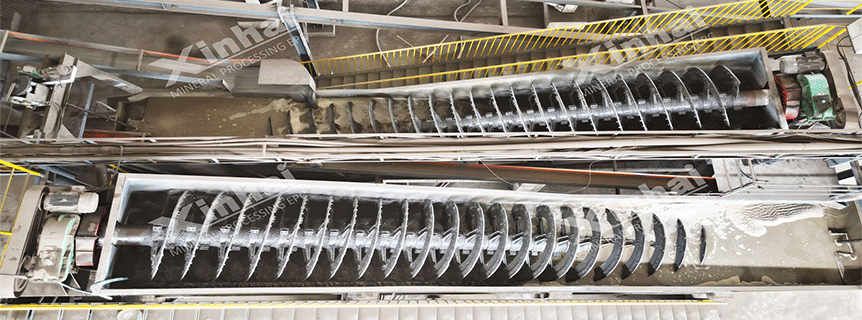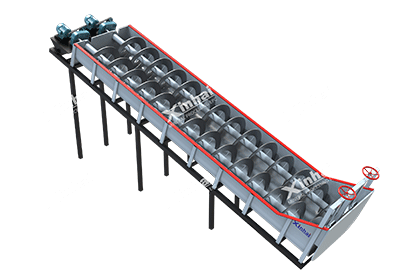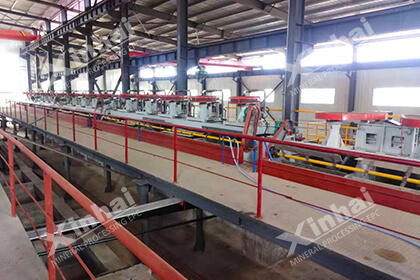Ore Beneficiation Equipment Guide: Comparison Between Hydrocyclone and Spiral Classifier
 Sheena
Sheena
 Sep 12, 2024
Sep 12, 2024
 750
750
If you want to know more details about equipment, solutions, etc, please click the button below for free consultation, or leave your requirements!

Field-diagram-of-a-mineral-processing-of-spiral-classifier
In the ore beneficiation process, the classification of the ore is a key step. In order to achieve the best sorting effect, classification equipment is usually used to process the ore.
Hydrocyclone and spiral classifier are the two most commonly used classifying equipment, they are different in structure, working principle, performance characteristics, etc., suitable for different application scenarios. In this article, we will compare the characteristics of these two types of equipment in detail to help you make the best choice in the process of mineral processing.
01Comparison of working principle
Back1. hydrocyclone
Hydrocyclone mainly relies on centrifugal force and fluid resistance to classify the solid particles in the slurry. When the slurry enters the inlet of the cyclone tangentially with a certain pressure, a high-speed rotating flow field will be formed in the cylindrical cyclone. Due to the centrifugal force, the coarse particles with large density are thrown to the outer wall of the cyclone and move downward along the wall, and finally discharged from the underflow port; while the fine particles with small density are concentrated in the center area of the cyclone, and discharged from the overflow port under the action of the rising water flow.
This equipment can carry out rapid classification in a relatively short time, especially suitable for processing fine-grained ores, with high efficiency, high precision, simple operation and other advantages. Hydrocyclone is commonly used in desliming and dewatering of concentrate and tailings as well as thickening of slurry.
2. Spiral classifier
Spiral classifier is a device that utilizes gravity and water flow to classify ore particles. After the slurry enters the grading tank from the feeder, the spiral blades installed in the tank rotate continuously, bringing the coarse particles in the slurry to the upper discharge port, while the fine particles will be carried away by the water flow and discharged from the overflow port. The structure of spiral classifier is simple, usually consists of classification tank, spiral blade, transmission device and other parts, suitable for coarse grading of ore as well as slurry concentration and desliming.
As the spiral classifier mainly relies on the rotation of mechanical parts and gravity, its processing capacity is relatively small, low precision, but low energy consumption, maintenance and operation costs are relatively high.
02Comparison of performance characteristics
Back1. Classification precision
Hydrocyclone has obvious advantages in grading accuracy, and can separate fine particles more accurately. Therefore, hydrocyclone is the preferred equipment in the occasions where high precision classification is required. While the spiral classifier mainly relies on gravity separation, the grading accuracy is relatively low, and it is more suitable for the grading of coarse-grained ores.
2. Processing capacity
Hydrocyclone has a large processing capacity, suitable for large-scale continuous production, and covers a small area. It can process a large amount of slurry in a short time, which is very suitable for ore dressing occasions that require rapid processing. The spiral classifier has a smaller processing capacity and a relatively large footprint, which is suitable for small and medium-sized beneficiation plants or application scenarios with smaller processing capacity.
3. Energy consumption and operating costs
In terms of energy consumption, hydrocyclone requires high-pressure pump drive, relatively high energy consumption; while the spiral classifier mainly relies on mechanical movement and gravity, low energy consumption. However, in terms of long-term operation and maintenance costs, hydrocyclone is more economical to operate due to its simple structure and lower maintenance costs. Spiral classifier has more mechanical parts, easy to wear and damage, so the maintenance cost is higher.
4. Applicable slurry concentration
Hydrocyclone is suitable for processing high concentration slurry, especially in the process of rapid thickening or desliming. Spiral classifier is suitable for processing low concentration slurry, when the slurry contains a large amount of water, its classification effect is better.
03The choice of application scenarios
Back1. Application scenarios of hydrocyclone
Hydrocyclone is widely used in the fine grading and desliming process of non-ferrous metal ores, ferrous metal ores, non-metallic ores, and is especially suitable for occasions requiring high-precision grading. For example, in the concentration of fine-grained minerals, recovery of fine sand and desliming of tailings, hydrocyclone has excellent performance.
2. Application Scenarios of Spiral Classifier
Spiral classifier, on the other hand, is suitable for coarse-grained material classification, slurry concentration and desliming processes. It is used more in the pretreatment stage of the re-election process, which is used to provide suitable particle size materials for the subsequent re-election equipment. In addition, spiral classifier in the production process of sand and gravel plant, building materials plant, is also commonly used in sand and gravel, slurry cleaning and grading.
04Suggestions for equipment selection
BackIn the beneficiation process, the selection of suitable grading equipment needs to take into account a variety of factors, including the nature of the ore, processing capacity requirements, energy consumption and operating costs, site conditions and so on.
1. Ore nature
If the ore size is fine and need high precision classification, it is recommended to choose hydrocyclone; if the ore size is coarse and need to deal with low concentration slurry, the spiral classifier is more suitable.
2. Capacity requirements
Hydrocyclone is suitable for large-scale continuous production, large capacity and small footprint; while the spiral classifier is suitable for relatively small capacity occasions.
3. Energy consumption and cost
If energy consumption is sensitive and frequent maintenance is often required in production, spiral classifier may be more suitable; if long-term operating costs and ease of equipment maintenance are taken into account, hydrocyclone is more advantageous.
4. Installation and site conditions
Hydrocyclone covers a small area, suitable for space-constrained factories; spiral classifier requires a larger installation site.
05Summary
BackIn the ore dressing process, hydrocyclone and spiral classifier have their own characteristics. Hydrocyclone is suitable for high-precision, large processing capacity, need to quickly classify the occasion, while the spiral classifier is suitable for coarse-grained materials and lower concentration of slurry classification. According to the actual production demand and site conditions, a reasonable choice of equipment type can maximize the efficiency and economic benefits of mineral processing.
Through in-depth understanding of the characteristics of these two types of equipment and applicable scenarios, you can make better decisions, choose the classification equipment that best meets the production requirements, and realize the optimization and enhancement of the beneficiation process.
 +86 18716000713
+86 18716000713 xlyin@xinhaimining.net
xlyin@xinhaimining.net




 Message
Message Chat Now
Chat Now

















